Think of a place full of serene forests, echoing the chatter of elegant blue birds. Full of crisp lakes that give you the feeling you’re on the sea. Full of active volcanoes and rough beaches that are a dream come true for surfers. As you’re taking in the sun-salt smell, the water swirls under your feet, and the ocean foams soft white patterns on black sand around you. When backpacking in Nicaragua, all these images that have just formed in your head can come to life.
“Bienvenidos a la tierra del pinolero!” my friend smiles. Not only he, who’s lived in Nicaragua for half a year, but many fellow travelers were raving about the country. So we were super curious about backpacking in Nicaragua. About volcano boarding, about the chilled surfer towns, about an island made up of two volcanoes.
And one thing I can already admit: We were not disappointed at all.
Even though Nicaragua is one of the largest Central American countries, you don’t have to take many long bus rides. Most of the things to do in Nicaragua are found in the southern part of the country, close to the Pacific. That’s also where 80% of the population lives.
Dominated mostly by jungles, the inland is where coffee, cacao, and beans grow.
So let’s take a look at the different places that are worth seeing on your Nicaragua backpacking itinerary.
Table of contents
Places to see when backpacking in Nicaragua
Momotombo 2 day hike
Maderas Volcano crater lake
Las Peñitas
Playa Popoyo
Lakes & rivers
Ometepe Island
Somoto Canyon
Nicaragua Backpacking itineraries
2-weeks Nicaragua itinerary
3-weeks Nicaragua itinerary
Sustainable travel in Nicaragua
Good to know
What’s the best time for Nicaragua?


Places to see when backpacking in Nicaragua
Like most Central American countries, Nicaragua is a very diverse country with stunning nature. It’s becoming the most popular backpacking destination in Central America. And that’s for good reason. There are so many things to do in Nicaragua!
Most backpackers stick to the southern part where distances aren’t too awful. Yet you can find awesome towns, beaches, volcano hikes, lakes and more amazing nature quite close to each other.
Colonial towns
León
Coming from the north, the first thing we noticed about León was that it’s the first Central American town that wasn’t cobblestoned. And the second thing: Street food! As a huge street food lover, my heart filled with joy. The third thing: Well, heat! With around 36 degrees during the day, walking through the town seemed quite unbearable. But that shouldn’t keep you from exploring.
León is worth an excursion with its beautiful white cathedral that makes you think you’re in Greece. For the best view of the city and the surrounding volcanoes, take the time to climb onto the cathedral’s whitewashed roof in the late afternoon for just 105 Cordobas (less than 3 US$).
Watch the busy city being carried into the evening when the sun goes down.
Besides, during your stroll, you encounter plenty of street art picturing revolutionary scenes. These large murals are not only beautiful pieces of art but also important portrayals of Nicaragua’s people and their country’s past.
You also shouldn’t miss exploring the markets, get some exotic fruit and try Pinol – the refreshing, sweet national drink of Nicaragua.
Moreover, one of the most interesting things to do in Nicaragua is the free walking tour through León with Leonel who not only gives you a good overview of the city and culture but also about Nicaraguan history. With his positive spirit and curiosity, you can feel how passionate he is about his city and country. Exploring León with Leonel feels like walking through the town with a friend. I can highly recommend it for your Nicaragua backpacking trip!
Last but not least, León is the perfect base to explore some of the surrounding volcanoes. The most popular activity over here is hiking up Cerro Negro which you can slide down on a wooden board – volcano boarding.
Eat & sleep in León
We enjoyed our stay with ViaVia León. Not only is it a great backpackers hub but locals also like to meet here for a game of pool.
Besides street food and eating in local Comedores, you should check out Coco Calala. If you want to treat yourself, come here for amazing vegan food and a pool to refresh from the heat.
The town of León
Granada
Granada is colorful. Granada is extremely pretty. And well, Granada can also be a bit overwhelming. Especially on weekend evenings, when the bars on the main street Calle La Calzada try to outplay each other with the loudest music.
“It’s the most secure street throughout Nicaragua”, our host tells us. And I’m sure it’s also the most touristy one.
That said, Granada is indeed a pretty town. With its neat colonial architecture, it is nicely located right by the lake which calls for different activities. There are some nice cafés and hotels for all budgets that seem like oases within the hot town.
Located along its main square are a beautiful cathedral and lots of colonial buildings that make you feel like you’re somewhere in Europe.
After checking out the square, churches, and colorful streets you should definitely visit the market for the bustling, authentic side of Granada. Besides, there’s plenty to do in and around Granada. It’s the perfect base to visit some of the best things to do in Nicaragua, such as Masaya Volcano after dawn to watch the boiling lava streams and the refreshing Laguna de Apoyo.
The town of Granada
Las Isletas de Granada
Among the most popular activities when backpacking in Nicaragua is a boat trip to Las Isletas. With way over 300 tiny islands on the lake, this looked extremely interesting on Google Maps and sounded like a nice tour to experience authentic Nica lake life. Unfortunately, it wasn’t. For us, this boat trip turned out to be one of the most overrated things to do in Nicaragua. We were quite disappointed, as it was more like a tour through expensive villas of more or less famous celebrities. As if this wasn’t enough, we were brought to two small islands inhabited by monkeys. As the monkeys clearly didn’t end up on these tiny islands in a natural way, we asked our guide about the background. As suspected, the poor creatures were brought here by men and were now captured in a natural prison for the sake of photo-greedy tourists. So sad!
Better rent a kayak and explore the islands and the lake by yourself!
The town of Granada & Las Isletas

Las Isletas
Eat & sleep in Granada
There are so many options to eat in Granada. One you should definitely check out is Tostometro Banana Burger. In the old house of his mother, right next to the bustling market, the owner has created a unique place for foodies. You get just one dish over here: a wheat-free burger with fried plantains instead of a bun. The vegan burger was packed with so many veggies and we even got a homemade sweet treat on the house afterward. Yummy!
As Granada gets extremely hot during the day, you want to have a place with a pool, believe me! To sleep in a calm haven right in Granada’s hectic center, I can highly recommend Maharaja Boutique Hotel. Very lovely and helpful owners and a beautiful, small courtyard with a pool. If you’re looking for a treat, check out Boutique Hotel Secret Garden.
For more of a hostel feeling to meet other travelers and hang out together by the pool, head to Oasis Hostel.
An epic stay in the jungle outside of town can be found in The Treehouse. Famous for its tiny Bungalows on top of the trees, ziplining, and their rave on Fridays for the party junkies.
Tostometro Plantain Burger
San Juan del Sur
Loved by young backpackers, its reputation as a party place is not a secret. What Palma de Mallorca is in Europe, San Juan del Sur seems to be in Nicaragua.
Just as tanktops of The Treehouse or Volcano Boarding, you’ll see youngsters wearing “Sunday Funday” shirts everywhere. It’s like a huge pub crawl across the whole city every Sunday. So if you’re in the mood for a party, head there for what may turn out as the most fun thing to do in Nicaragua. If you don’t feel like party, stay away. Especially on weekends!
Volcano adventures
Looking at the Nicaraguan Cordobas (which are quite beautiful bills, by the way) you can spot where the country’s pride lies. Of course, it’s the volcanoes. With 19 volcanoes spread along the country’s Pacific coast, there’s quite a density. So in almost every town or place, you visit you can find volcano activities. Here’s just a small selection of special volcano experiences when backpacking in Nicaragua.
Cerro Negro Volcano boarding
Already when you’re traveling through other countries in Central America, again and again you bump into backpackers with a shirt proudly stating that they went volcano boarding.
The most popular slope is Cerro Negro, which is a 45-minute drive from León. You can actually see the “black hill” as its name indicates, from the top of León’s cathedral. It’s clearly the darkest of the volcanoes. And it’s also the youngest, with its last eruption in 1999.
So Cerro Negro has become famous for this extraordinary activity of volcanoes boarding. Some say, it’s one of the things to do in Nicaragua that you can’t miss. Others say it’s overrated. Well, maybe you have to find out yourself. In order to do so, you have to climb up the small volcano for around 45 minutes, and after gazing into its spectacular crater you throw on a pair of sexy overalls and slide down on the wooden board that you carried up.
You can book this adventure with many hostels in León which will cost around 30 US$ including transport, some guides, all the sexy equipment, and some refreshments.
Boarding down Cerro Negro
Momotombo 2 day hike
Did you know that there was a town called León Viejo (“old León”)? It was destroyed by an eruption of Momotombo in the 1600s. Today, there are only ruins left and the new León has become the best base to start volcano hiking.
The hike up Momotombo is said to be a really hard one and should include one night in a base camp. It may be among the most exhausting things to do in Nicaragua and it’s almost not possible to go up and down again on the same day.
Masaya Volcano by night
Possibly the most accessible volcano in the world, Masaya can be reached by car. It’s just a short drive from Granada and you can drive right to its crater where you can see the lava boiling. As you don’t even have to hike for a spectacular view, this volcano is loved by locals. Many tours leave Granada just before sunset for an amazing view of glowing lava in the dark.
Swim in a crater lake on top of Maderas Volcano
One of two volcanoes making up the island of Ometepe is Maderas. It’s apparently the smaller one, but still a full day trip to hike up and down again. Being a dormant volcano, the terrain is surprisingly lush with lots of wildlife to be found. You may hear the cries of howler monkeys and many birds during your hike. With such diverse flora and fauna, Maderas has become a designated UNESCO biosphere reserve.
The best part awaits you after a sweaty hike: You can not only admire the amazing view of the crater lake but also swim there.
Volcano hiking & boarding down Cerro Negro
Volcano hiking
Surfing on the Pacific coast
All your surfer friends won’t stop raving about the beaches along Nicaragua’s Pacific coast. From fancy surf hostels, and chilled vibes, to neat cafés. You’ll find all of it along the country’s long stretch of beaches. If one beach experience isn’t enough, you can hop from one to the next.
Las Peñitas
Ready to board some waves again after volcano boarding?
Super close to León, this is the perfect beach break where you can jump into the Pacific ocean.
Stay at Mano o Mano Eco Hostel in Las Peñitas where you can sip a beer, relax and unwind right by the roaring waves.
Playa Gigante
Even though just around an hour north of San Juan del Sur, Playa Gigante is a rather calm surf town. In this village, you can still feel quite a local vibe and calm down for a few days during your Nicaragua backpacking adventure.
Walk up the small hill for one of the nicest sunsets in Central America.
Playa Popoyo
Not far from Playa Gigante you can find another laidback surfer hub. Loved by beginners as well as surf pros, Playa Popoyo is becoming more and more popular. Probably it won’t be as authentic anymore in a few years, so one of the smartest things to do in Nicaragua may be to check it out now!


Low tide on the Pacific coast
Lakes & rivers
Nicaragua wouldn’t be Nicaragua without its lagoons and especially the huge Lake dominating the country’s shape.
They’re all full of adventure potential with warm volcanic waters where you can kayak and even bull sharks in the large Lake Cocibolca. Nicaragua’s waters invite you to go swimming, kayaking, and relax with a Flor de Caña rum in hand after an exciting day.
Laguna de Apoyo
A lagoon that was created when a volcano collapsed and the huge crater filled with water thousands of years ago. Sounds exciting? It is! Because of the volcano, the water in the lagoon is also quite warm at around 28 degrees.
And even better, it’s the cleanest lake in Nicaragua. That’s some good news after we’ve seen some dirt holes and heard of people getting Parasites from swimming in Central America.
So Laguna de Apoyo is perfect for swimming, kayaking, paddleboarding, or hanging out by the lakeside.
Relaxing over there became one of my favorite things to do on our Nicaragua backpacking trip!
Paradiso Hostel is the perfect place to chill right by the shore of the freshwater lake. Treat yourself to one or two nights here to calm down and unwind.
However, food is quite expensive over there, so head to Comedor Angelito a few minutes up the road where you can get great local food for affordable prices. Try their fresh mango juice! It’s the best we had in the whole country (finally one that’s not watery).
Relaxing & kayaking at Laguna de Apoyo
Ometepe Island
Imagine an island made up of two volcanoes. In a lake so huge it makes you feel like you’re in the sea. Full of sandy beaches, undeveloped villages, and exciting nature.
Well, honestly you’ll have the impression that you’re by the sea all the time over there (and that’s not because it’s the only lake in the world with sharks). Lago di Cocibolca is just so gigantic that oftentimes you don’t even see the shore.
Ometepe is actually the largest lake island in the world. You can reach it by a one-hour ferry ride from San Jorge (close to Rivas).
That said, don’t miss renting a scooter and riding around the dirt tracks to explore the island’s jungles, hidden lagoons, waterfalls, and viewpoints. A rental is around 20 $ a day and allows you to let out the adventurer in you! Without a scooter, you won’t be able to see the island properly as the bus connection is quite poor. We left most of our luggage at the scooter rental Dinarte right by the port and just took some stuff that we needed for a few days on the island. They’re quite professional and you can directly ride to your accommodation with the wind blowing through your hair.
As you pass through the villages you can experience the authentic side of Nicaragua with Nicas playing soccer, gathering at their palm leaf-covered church, and barbecuing on the streets.
But be aware of chickens, street dogs, herds of cows, and wild horses crossing the roads.
Go out and explore by hiking one of the two volcanoes – Volcano Concepción being the larger one and the harder hike, or Volcano Maderas where you can view the spectacular crater lake.
After a day of hiking, you can jump into the natural crystal-clear pools at Ojo de Agua with water of volcanic origin. Or directly combine hiking with a refreshing shower under the crisp water of San Ramón Waterfall which is an incredible 60 meters high.
Up for more action? Then don’t miss the ziplining tour where you can fly across the jungly treetops.
Besides, Ometepe is great to hang out by the beach as well. Yeah, you got that right. With beautiful beaches like Playa Santa Cruz, the island has some of the finest sand that I’ve experienced in Central America. Sounds unbelievable on a lake, right?
An awesome spot for sunset is Punta Jesús María with a spectacular volcano view and a sandbar.
This island offers such an amazing nature experience while it’s still totally authentic and rural. I totally get why many travelers get stuck here for weeks or months while backpacking in Nicaragua.
The lush island of Ometepe with its waterfalls, volcanoes and beaches
Food in Ometepe
If you’re in Ometepe on a Saturday, don’t miss the local farmers’ market in Santa Cruz where you can find organic local goods and yummy foods (so many vegan options). Strolling across the market for me was one of the nicest things to do in Nicaragua and the point where I ultimately fell in love with Ometepe. All these lovely locals selling home-cooked delicacies and wrapping them in banana leaves. My zero-waste heart jumped!
Besides the market check out El Pital with their own organic chocolate and a cute café on the lakeside.
A great place to eat is Cafe Campestre, where you can also get zero waste take-away, as it comes in Tupperware.
Indulging on Ometepe’s Saturday market

El Pital cacao bar
The best places to stay on Ometepe
For a great mix of a local experience but also close to many nice spots for activity, cafés, and restaurants the area around Santa Cruz and Balgue is perfect.
We had the best time at Casa Papaki, the lovely house of Teresa, in the middle of their lush garden and vegetable farm. When entering after our scooter ride across the island we were greeted by six tiny to huge dogs longing for cuddles. And we directly felt at home! The room is one of the nicest we stayed in during our time in Central America and the hammock on our balcony easily became my favorite spot. Watching the bluebirds singing and playing around the palm trees surrounding us was awesome. Also, Teresa is a great chef whipping up delicious dishes farm-to-fork with the fresh produce from her garden.

For a more jungly experience, you should check out Selvista Guesthouses. They have beautiful bungalows in the middle of the forests near Balgue. You can pick and eat any fruit that you find on the surrounding trees – mangoes, starfruit, maracuya, guanabana, and tamarind. All fresh and waiting for you to treat yourself. A dream! The breakfast prepared every morning is also prepared from the farm produce.
Our terrace at Selvista
El Pital cacao bar & Casa Papaki in Ometepe
Somoto Canyon
Crystal clear water to swim in, some cliffs to jump, and hiking around a remote canyon. That’s what awaits you in Nicaragua’s Somoto Canyon. Fewer backpackers make it here but it’s a true gem. It’s only been rediscovered in 2004, so one of the best things to do in Nicaragua off-grid. So if you’ve got some time to spare, consider taking the five-hour chicken bus ride from León to explore a different and very authentic side of Nicaragua.
It’s recommended to hire a guide at the park’s entrance in order to be prepared for the adventures around the canyon’s river.
White beaches in the Caribbean
How about getting off the beaten track and spending some days on empty, white beaches? If that sounds like a dream to you, it’s possible on your Nicaragua backpacking trip. Well, possible but hard to get to. It’s a journey of more than a day. But let’s be honest, where else can you experience untouched Caribbean islands?
The Corn Islands
Being so far away from the typical Nicaragua backpacking itinerary, only a few travelers make it here. But those who do say it’s one of the most unique things to do in Nicaragua and never want to leave again.
Little Corn is a paradise for backpackers with virgin beaches where you can hang out in a hammock all day. There are no cars on the island and there’s no need to. It’s all about relaxing on the white beaches with a coconut in hand, swimming in the calm sea, and enjoying island life on a hammock.
As the name suggests, Big Corn is the larger island but you can easily get a boat from one to another for around 6$ in half an hour.
In order to get there, you should plan two days if you want to avoid flying. First, you have to take a bus from Managua to Rama. After staying a night in Rama, catch the early ferry to Bluefield and another boat to the Corn Islands.
It’s a long trip but extremely worth it, as it’s just so different from the rest of Nicaragua. And I’m sure it won’t stay this undiscovered forever. So make your way up there now!
The perfect place to stay on Little Corn is Lighthouse Hotel – An oasis on a little hill where you sleep in a gorgeous little room among mango trees. What else could you ask for on a little island?
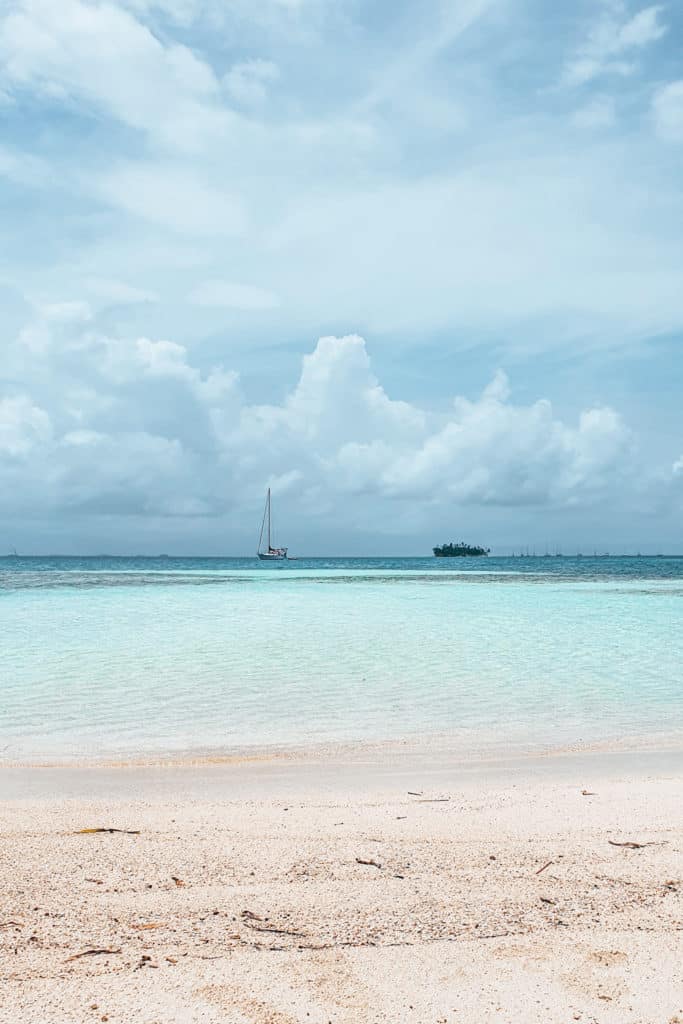

Caribbean beaches in Central America
Nicaragua backpacking itinerary
Backpacking in Nicaragua is easy as most places are fairly close to each other and there’s a great network of local buses. As opposed to traveling in Guatemala, you probably won’t need to take any 10-hour bus ride on your Nicaragua itinerary. The only exception is if you decide to see the Corn Islands on the Caribbean coast. Almost all other spots and things to do in Nicaragua are scattered along the Pacific side of the country.
2-weeks itinerary for backpacking in Nicaragua
- Start in León: If you enter Nicaragua from the north (e.g. from Honduras), your first stop is probably León. Immerse yourself in this bustling colonial town, check out its markets, revolutionary murals, and the cathedral, and join the free walking tour.
- Volcano hiking: With León as a base, you can go on the famous volcano boarding adventure on the volcano Cerro Negro for a half-day trip. Also, you can hike some of the other surrounding volcanoes as a full-day trip.
- From Leon to Las Peñitas: In case you feel like the beach after the volcano hike, add a stop in Las Peñitas which you can easily reach by bus from León in around half an hour. It’s only around 100 C$ (less than 3 US$). To move on afterward, you have to go through León again.
- Bus from León to Granada: The bus trip from León to Granada is super easy and takes around 3 hours. From León’s bus terminal take a bus to Managua, where you quickly change to another bus to beautiful Granada. Enjoy the beautiful architecture and explore the surrounding islands by kayak or head on some night adventure onto Masaya Volcano.
- On to Laguna de Apoyo: In only half an hour from Granada you reach this little oasis. There’s a daily shuttle leaving at Oasis Hostel to Paradiso Hostel every morning at 10 for 3 $. Just head there a day before and reserve a spot. I’d definitely stay a few nights in this awesome nature by the lake!When leaving Laguna de Apoyo there’s one daily bus at 11:30 a.m. taking you to the main road close to La Garza where you can hop onto another bus to Granada. The trip is around 50 Cordobas (around 1,20 $). Or take the shuttle at 4 p.m. for 3 $.
- Bus to Ometepe: From Granada, there are several buses to Rivas every day. You have to change in Rivas to another short bus to San Jorge where the ferry leaves. Leave Granada early, with the 1:30 p.m. bus at the latest in order to catch the 4 p.m. ferry to arrive in Ometepe before sunrise. You can rent a scooter in Moyogalpa (the town in which the ferry arrives) and leave your big backpack there to just take a small one with you with the stuff you need for a few days on the island.
- From Ometepe to one of the Pacific beaches: In the south of Nicaragua, you always have to pass through Rivas. So take an early ferry back from Moyogalpa in Ometepe and a short bus ride from San Jorge to Rivas. From here you can catch a bus down to the Pacific for some surfing.
- On to Costa Rica: In case your Central America journey continues south, there is a bus that goes straight from Rivas to the border of Peñas Blancas. After the border, you can take a bus to San José or to Liberia, a large bus terminal from where you can get to many parts of Costa Rica.
2 weeks Nicaragua backpacking itinerary in short:
Coming from the north:
2-3 days León -> 2 days Las Peñitas -> 2-3 days Granada -> 2 days Laguna de Apoyo -> 3-4 days Ometepe -> 2-3 days Playa Gigante or Playa Popoyo (instead of Las Peñitas)
Coming from the south (Costa Rica):
Take the same Nicaragua itinerary, just the other way around.
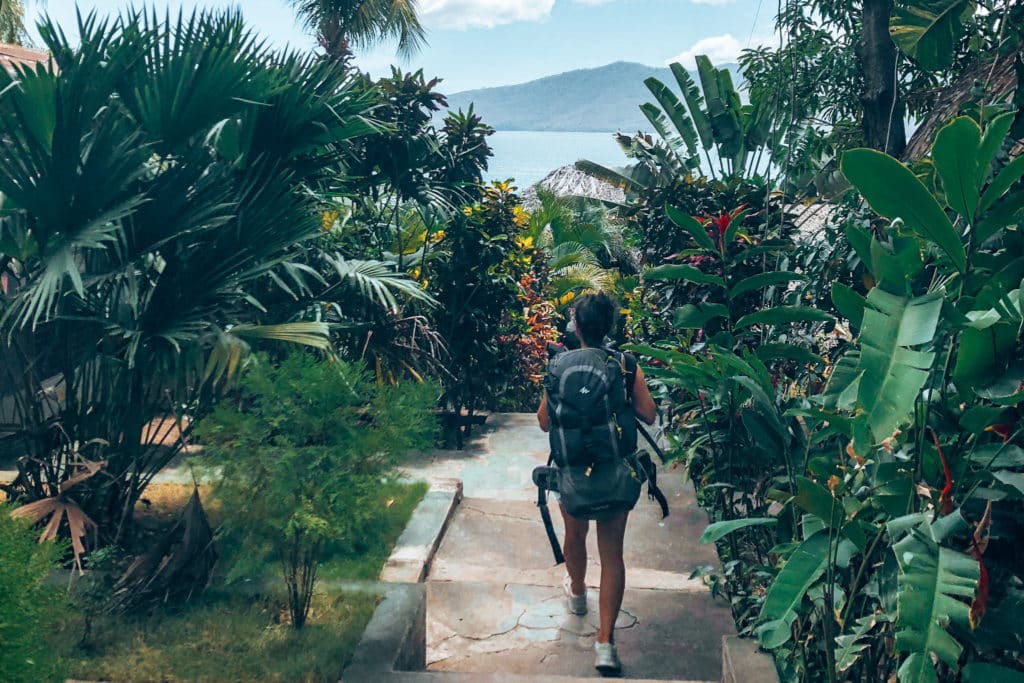

Backpacking in Nicaragua
3-weeks itinerary for backpacking in Nicaragua
With a little more time backpacking in Nicaragua, you can take the same Nicaragua itinerary as mentioned above for 2 weeks and add some more stops.
- 2 days Somoto Canyon: From León or Managua, take a chicken bus to Esteli, change to a bus to the town of Somoto and then another one to La Playa. From this village, it’s just a ten-minute walk to reach the canyon. You can find accommodation in Somoto or in Esteli.
- 3 days Corn Islands: After León or Granada, you can head to Managua to start the adventurous trip to the Corn Islands.From Managua (Mayorero bus station), take a bus to Rama. After staying a night in Rama, catch the early ferry to Bluefield and another boat to the Corn Islands.
3 weeks Nicaragua backpacking itinerary in short:
Coming from the north:
2-3 days León -> 2 days Somoto Canyon -> 4-5 days Corn Islands -> 2-3 days Granada -> 2 days Laguna de Apoyo -> 3-4 days Ometepe -> 2-3 days Playa Gigante or Playa Popoyo
Coming from the south (Costa Rica):
Take the same Nicaragua itinerary, just the other way around.


On the ferry to Ometepe island
Sustainable travel in Nicaragua
As the second-fastest-growing destination in America, Nicaragua is emerging as a sustainable tourism destination. They’re already doing a lot of things right. Not only was the first meeting of Regional Agencies of Sustainable Tourism hosted in Nicaragua, but also many small farming communities run by locals have started programs that promote sustainable tourism.
Moreover, there are also several tour operators which are part of Rainforest Alliance’s “Tour Operators Promoting Sustainability” program (TOPS). These tour operators select accommodation, transport, and guides dedicated to sustainability. This means they have to follow measures such as environmentally friendly practices, fair wages and get special training for their guides.
As a result of all the efforts of tourism companies, Nicaragua gained the award for ‘Sustainable and Responsible Tourism Destination’ in 2017.
How we can be sustainable travelers in Nicaragua?
Besides the responsibility of the country itself, we as travelers have a responsibility as well when we’re backpacking in Nicaragua.
As “the land of lakes and volcanoes” Nicaragua offers some incredible nature. But to enjoy these surroundings, we have to make sure to treat them wisely. With the way we travel, we can either benefit or harm a country immensely.
So, let’s make the right choices.
- The right accommodation – It doesn’t have to be an expensive eco-lodge if you want a sustainable Nicaragua backpacking trip. There are affordable options as well such as Casa Papaki or Selvista Guesthouses in Ometepe.
- Sustainable tours – In case you’re interested in any tours, your choice of tour operator can make a difference as well. Careli Tours is one of the tour operators certified by Rainforest Alliance. They’re specialized in eco experiences and adventure tours in Nicaragua with a clear commitment to the conservation of Nicaragua’s ecosystems and wildlife, cultural preservation, and community development. For example, they founded an eco-school in Granada.
- Take the bus – When traveling to more remote places, transport options are always scarce. But it’s always possible. Along Nicaragua’s Pacific coast, it’s easy to get around by bus. And even the remote Corn Islands can be reached by a combination of bus and ferry, so you can avoid taking the plane.
- Avoid plastic – Tucked between two oceans, a lot of plastic trash washes up on Nicaragua’s coast. So do your part and avoid it whenever possible, e.g. by bringing a filter bottle, your own straw to slurp coconuts, and a reusable bag. One of the wisest things to do in Nicaragua, or basically anywhere, is to get used to refusing plastic packaging whenever it’s offered to you.
- Always choose local – That’s probably the easiest but most effective tip on sustainable travel that you can get. No matter if it comes to accommodation, food or tour guides, supporting locals is always the most sustainable option.
- Enjoy vegetarian options – It’s not a secret anymore that the meat industry is the worst CO2 polluter. So the less meat and animal products we eat, the more sustainable we live.With Gallo Pinto (rice and beans) as a national dish, you will always have a vegetarian option. Besides, there are many nice vegetarian restaurants in the cities and also on Ometepe. We never struggled to find great food. My top tip for veggie lovers is the Saturday market in Ometepe.
Without a doubt, there are still so many things Nicaragua has to work on and so many obstacles to overcome when it comes to education and conservation. But they’re on the right path and far ahead of some otherCentral American countires.
At the same time, we as travelers won’t save the world overnight, but we can always try to be part of the solution and not the problem.

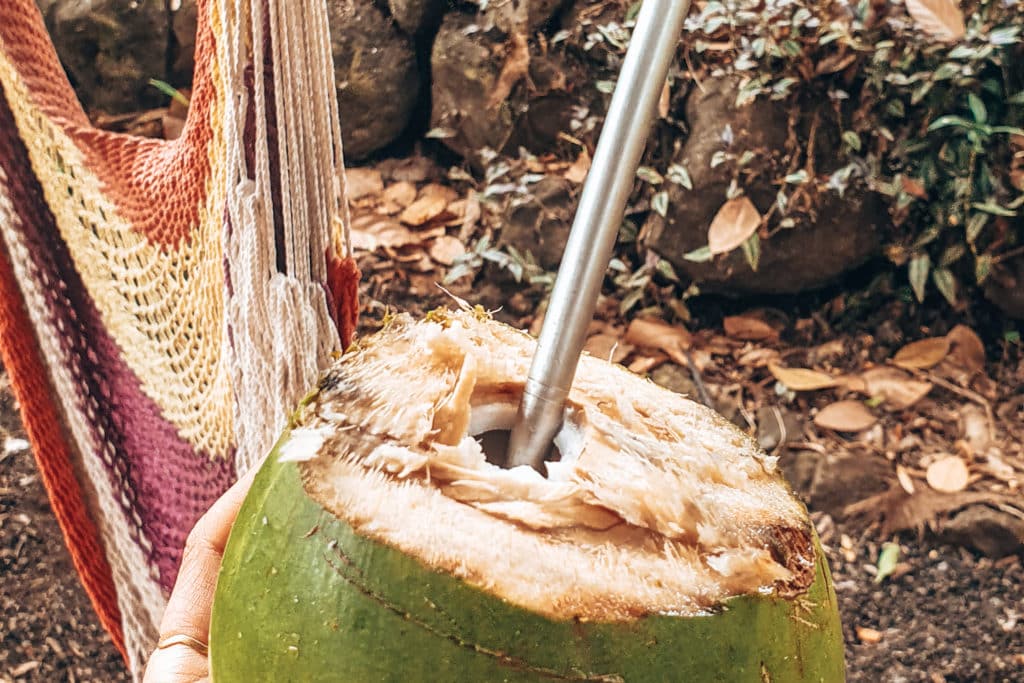
A reusable straw helps with sustainable travel in Nicaragua
Good to know
Food Nicaragüense
You won’t be able to go backpacking in Nicaragua without eating Gallo Pinto. If you want to or not. Because it’s literally served with anything and Nicaraguans eat it any time of the day. And even though it’s so simple (rice mixed with beans) it’s so yummy. Even though the name means dotted rooster, there’s no chicken or any meat inside!
Besides, you can often find fried plantains as a side dish, as well as corn and a cabbage salad. The trees are full of avocados which can be found in many dishes (or just buy some tortillas and snack them with avocado).
The Caribbean coast also uses coconut as a major ingredient in their dishes, such as creamy stews. And the Gallo Pinto here is roasted with coconut oil, giving it a nice coconut flavor.
For a sweet refreshing drink, try pinolillo (or also called pinol) – a creamy drink based on cornmeal and cacao. Or some freshly pressed orange juice on the street. The country is full of fresh fruit, so there’s always something to refresh yourself in between exploring all the coolest things to do in Nicaragua!
Fresh juice on the street, fresh fruits on the market and of course Gallo Pinto
What’s the best time to go backpacking in Nicaragua?
Similar to other Central American countries, the best time for a visit is supposed to be during the dry season between November and April.
But be prepared for more tourists and higher prices for accommodation around Christmas and New Years and around Easter.
During the rainy season from May to October, it can get really hard to reach some of the more remote destinations as it does rain a lot. Hiking with muddy paths will also be less fun and there’s less chance of a sunny day by the beach. So traveling in the rainy season isn’t really the best thing to do in Nicaragua.
Is Nicaragua safe to travel?
In comparison to its neighbors Honduras and El Salvador, Nicaragua is said to be way safer for backpackers. We actually never felt unsafe during our whole time in Central America, and especially relaxed in Nicaragua. The locals are super friendly and helpful and we also haven’t heard of any incidents happening to other travelers we met on the road.
As always, I can only advise you to take the usual precautions, such as
- Leave your valuables locked at your accommodation
- Store your credit cards and cash in different places so you always have a money source left in case you’re mugged
- Don’t walk alone and travel by night in Central America
- Avoid the capitals and big cities in Central America, such as Managua (there’s not much to see anyway)
How to get around Nicaragua?
As most distances are short, traveling by local bus is not only easy and the cheapest option to get around, but it’s also always an adventure. We had bus journeys where locals took our day packs on their labs when the bus was full or they helped us choose the right bus and were always up for some small talk.
A bus trip that takes several hours will not cost you more than a few dollars.
To enter the country or move on to the next country, taking the Nica Bus (Nicaraguan bus company) or Tica Bus (Costa Rican bus company) is quite popular. We’ve never tried them but heard that they’re quite comfortable, reliable, and still way cheaper than taking a tourist shuttle.
That said, tourist shuttles are the most expensive but most straightforward option to get from one destination. However, I don’t see the point in paying 30 US$ for a 3-hour shuttle where you can also take a local bus for as little as 3 US$ that only takes a bit longer.
Is backpacking in Nicaragua cheap?
Well, cheap is always a matter of comparison. But for sure Nicaragua is way cheaper than its neighbors Costa Rica and El Salvador. Especially nice accommodation isn’t expensive at all. For a really nice double room in a beautiful small local hotel, we paid around 20 US$.
We had the feeling, that Honduras was a bit cheaper in terms of food but still had a very good time on a tight budget in Nicaragua. You can find a typical breakfast with Gallo Pinto, eggs, and fried plantain for around 100-120 (3-3,50 US$).
Local buses are also quite affordable. For around 4-5 US$ you can take a bus trip for several hours.
Do you need to speak Spanish to travel through Nicaragua?
Just like all over Central America, speaking Spanish will help you a lot. Especially when you want to engage with locals while you’re backpacking Nicaragua some basic Spanish skills will make your experience in Nicaragua more valuable. Also, when you want to take local buses and visit more authentic places and not only all the popular things to do in Nicaragua. It’s not only about finding help when you’re looking for the right bus, but also the interactions with locals you meet on the way. They’re always super happy about Spanish-speaking Gringos and love to chat a bit.


Lively streets of Granada by night
Backpacking in Nicaragua | a wrap-up
Nicaragua in three words: blue birds | gallo pinto | lake vibes
Did you know? Nicaragua lake is the only lake in the world with sharks.
Favorite photo spot: On top of Cerro Negro directly gazing into the crater that had erupted just over 20 years ago
Favorite food: The plantain burger at Tostometro
Can’t miss: Swimming in the warm volcanic water of Laguna de Apoyo
Did you ever go backpacking in Nicaragua? Any tips, experiences, or other things to do in Nicaragua that you’s like to share? Leave a comment below!



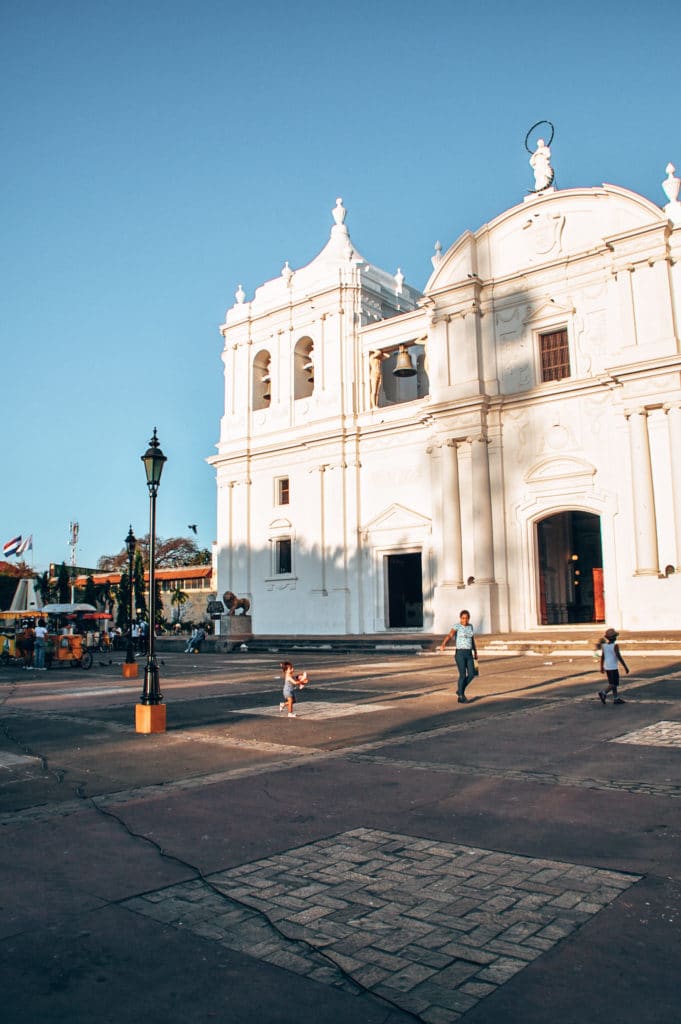



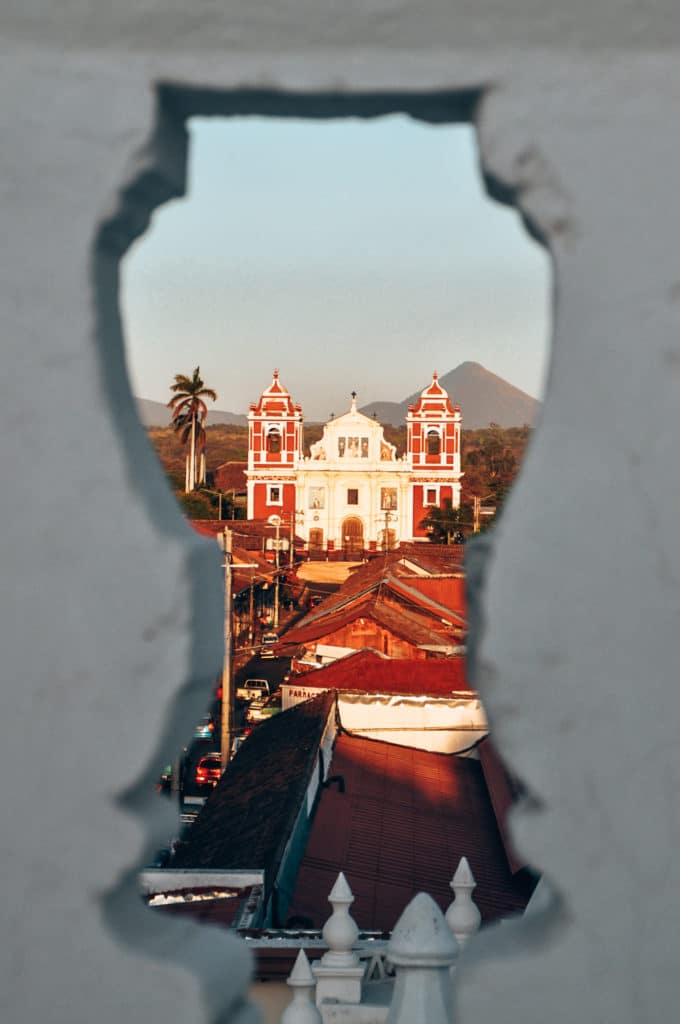
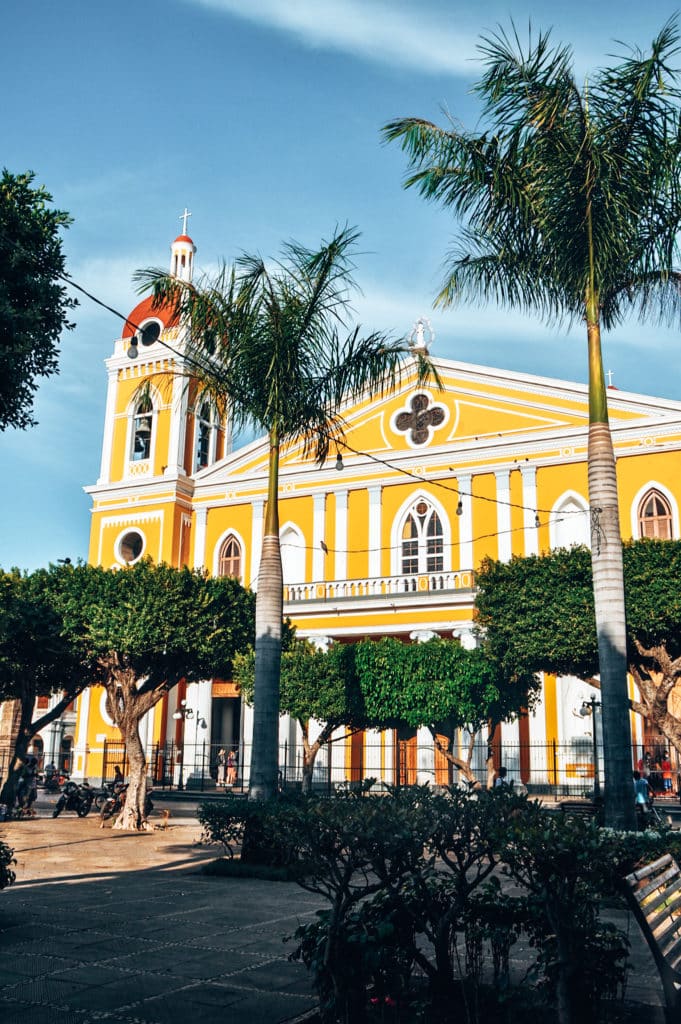

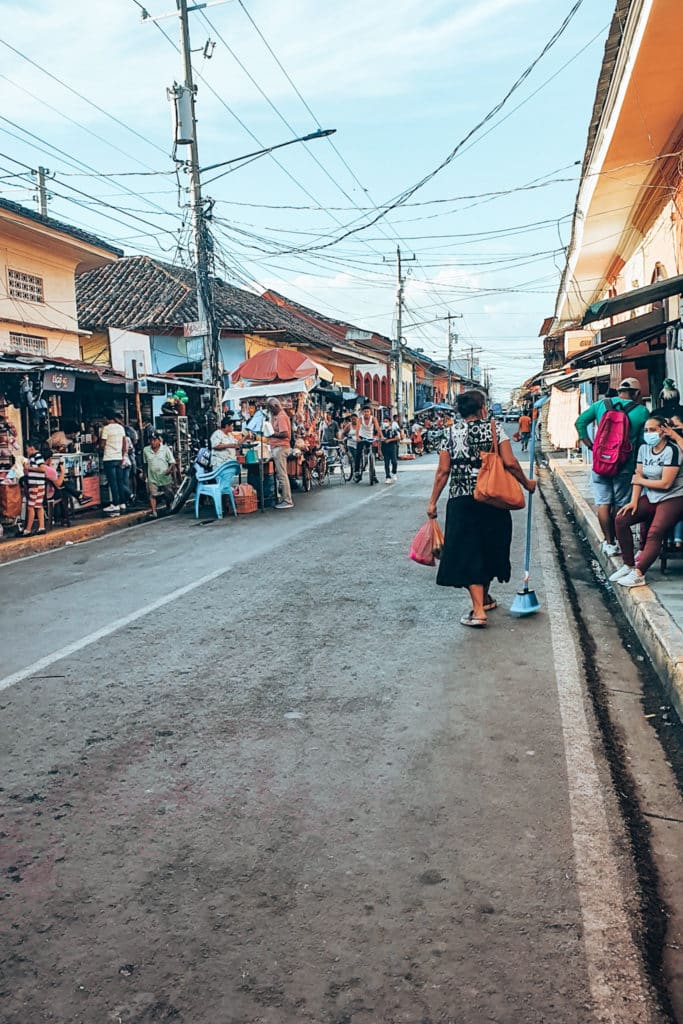



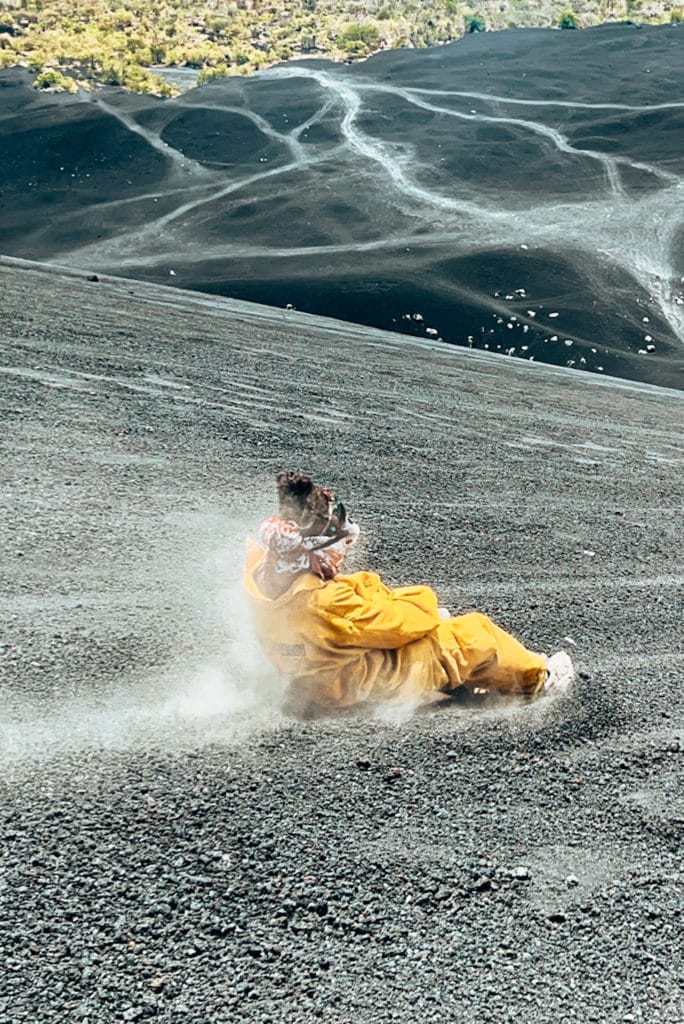











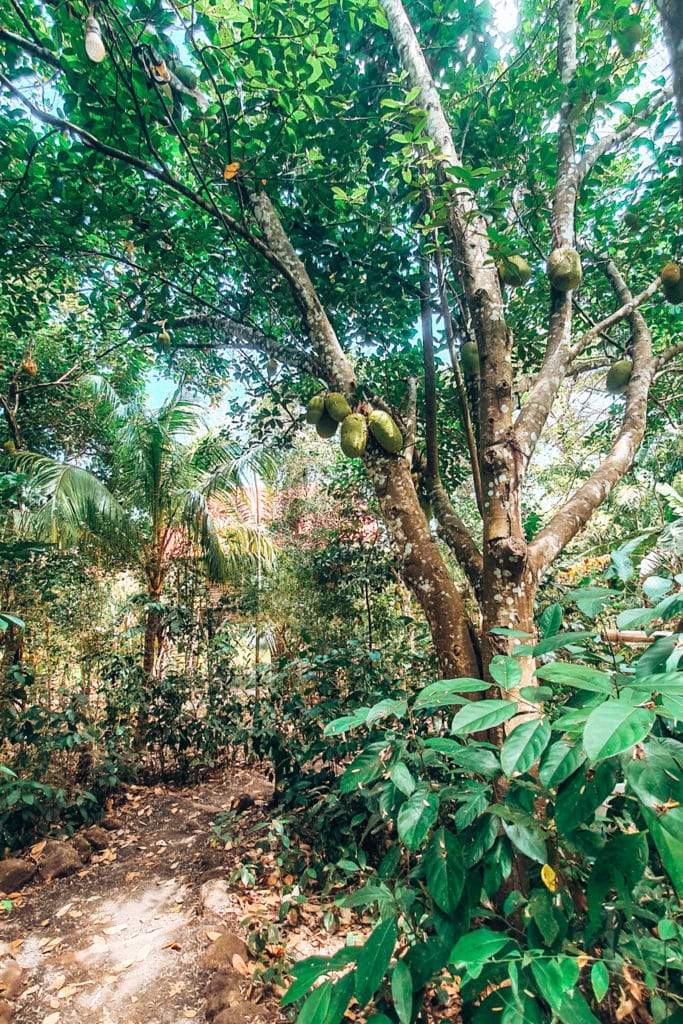














Leave A Comment